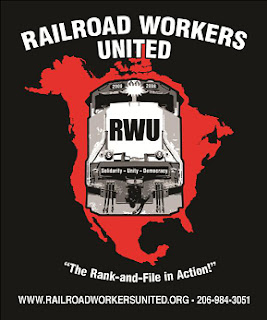We all know that rail carriers are looking down the road to using technology to reduce freight crew size to one person. Unfortunately many TE&Y people seem to be convinced that there is little we can do to stop this progression. But we believe it can be stopped with an organized campaign.
Will the BLET and UTU be able to mount an effective campaign to prevent one person train crews or will the carriers play them against each other in order to get one union to cave completely on the issue? Our assessment is that the two unions are not in any shape to mount a successful fight. Each union is affiliated with different parent unions, and they refused to cooperate in the last round of bargaining. And as it has been many years since the current officers have even worked T&E service, it is difficult to imagine that they have any real concept of what we are facing.
Railroad Workers United has begun this campaign against one person freight train crews. How do we propose the battle be won? What recent struggle can we use as a model for an effective campaign? In 1997, the Teamsters (IBT) fought United Parcel Service (UPS) and won one of the biggest labor victories in years. How did they do it?
IBT General President Ron Carey began preparing his campaign against UPS a year before the contract expired. The union circulated petitions among the members to gain support. They held rallies to motivate members and build communication networks among members in order to increase the mobilization effort. They established a website to maintain a flow of current information. They worked to ensure solidarity between part-time workers and full-time workers. They wanted no divisions in the ranks that UPS might capitalize on. Major resources were committed to this battle. UPS Teamsters were hired, pulled out of the shop for a year, to communicate face-to-face with members, and built networks in all barns across North America.
The Teamsters also worked to mount a public relations campaign in which they carefully crafted their message to the public. They made sure that everyone understood that they were striking for good full-time jobs. They used rank-and-file members in their public ads and statements so that the American public could empathize with strikers. It was a combination of these tactics and some political maneuvering which enabled the Teamsters to ultimately win their strike.Many Teamster members and local officers were skeptical that such a battle could be waged and won against such a powerful company. UPS fought hard, but union members worked hard to come together and stand with a collective, organized voice, and win. So using this example, RWU proposes the following tactics in order to fight single-employee train crews:
1.TE&Y employees, regardless of union membership, must help in the effort to educate ourselves and all our fellow workerss about the carriers' push for single person crews.
2. We have to make sure our elected union officials understand that we expect leadership and total commitment to winning this battle. They must understand that we expect them to commit substantial financial, public relation and political resources. We expect and demand complete unity and solidarity between the UTU and the BLET on this issue.
3. Single-employee crews are being negotiated on an on-property basis and not as a national contract issue. This means we must cast off our shackles of carrier, geographic, general committee and union boundaries and reach out to all of our co-workers to build the solidarity and strength we need to win. Implementation of single employee crews anywhere is a threat to the two-person crew everywhere!
4. We must each build a network of rank-and-file members who can effectively work to educate our friends, families and communities about the dangers of one person crews. These members must be able to present our message to the media and others in an effective and professional manner.
5. We must put the FRA and other regulators on notice that single employee crews are not safe and are not acceptable.
6. We must begin our efforts now and continue to build them until our union leaders, government regulators and the carriers understand that we will not relent.
As a dues paying, rank-and-file member, you are one of the true owners of your union. There is a lot you can do to help. Email us at no1personcrews@gmail.com to get on board. We will ensure you have all the materials you need. We understand that this will not be easy, but we also realize that this battle is absolutely crucial to the future of our jobs, the safety of our families and communities, the health of our Railroad Retirement and the safety of each and every one of our brothers and sisters.
Ed Michael, BLET#724 & UTU #979, UP, Salem, IL
Click Here to Get Involved
